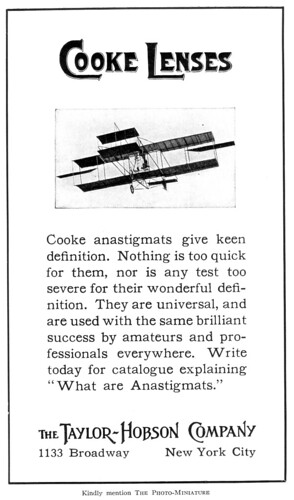Difference between revisions of "Taylor-Hobson"
m (→Notes) |
m (sc) |
||
| Line 5: | Line 5: | ||
|image_align= right | |image_align= right | ||
|image_text= US advertisement of 1913 | |image_text= US advertisement of 1913 | ||
| + | |scan_by=Uwe Kulick | ||
|image_rights=public domain 1923 | |image_rights=public domain 1923 | ||
}} | }} | ||
| Line 43: | Line 44: | ||
|image_align= center | |image_align= center | ||
|image_text= 1913 ad of [[Taylor-Hobson]] | |image_text= 1913 ad of [[Taylor-Hobson]] | ||
| − | | | + | |scan_by= Nesster |
|image_rights= commercial | |image_rights= commercial | ||
}} | }} | ||
Revision as of 16:26, 27 October 2012

|
| US advertisement of 1913 scanned by Uwe Kulick (Image rights) |
Taylor-Hobson are lens and precision instrument manufacturers based in Leicester, England.
The company was founded as T.S. and W. Taylor in 1886 by engineer William & optician Thomas Smithies Taylor. In 1887, W.S.H. Hobson joined the company.
In 1893 they produced their first Cooke lenses, designed by H. Dennis Taylor (no relation to the company founders) - optics manager of T. Cooke & Sons, York. Taylor was attempting to eliminate the aberrations at the outer edge of lenses, and in 1893 patented the Cooke triplet design (British patent no. 1991)[1]. Manufacturing rights were offered to Taylor, Taylor & Hobson, as the company was then known.
In 1932, the first Cooke zoom lens was introduced for cine applications. Around this time, Taylor, Taylor and Hobson was part-owned by Bell and Howell.[2] By 1939, Taylor-Hobson claim to have produced over 80% of lenses for film studios across the world[3]. Like much of the British photographic industry, the company became part of Rank at some time in the '40s.[2]
The company still exists, making lenses and lens measurement equipment, bearings, instruments and medical replacement joints - among other precision items[4]. It is currently part of the US-based Ametek, Inc. The separate lens company, Cooke Optics, also still exists in Leicester.
William Taylor was also responsible for testing golf balls in a wind tunnel, and developing a dimpled golf ball[3].
| British companies | ||
| Adams & Co. | Agilux | Aldis | APeM | Aptus | Artima | Barnet Ensign | Beard | Beck | Benetfink | Billcliff | Boots | British Ferrotype | Butcher | Chapman | Cooke | Corfield | Coronet | Dallmeyer | Dekko | De Vere | Dixons | Dollond | Elliott | Gandolfi | Gnome | Griffiths | G. Hare | Houghtons | Houghton-Butcher | Hunter | Ilford | Jackson | Johnson | Kentmere | Kershaw-Soho | Kodak Ltd. | Lancaster | Lejeune and Perken | Lizars | London & Paris Optic & Clock Company | Marion | Marlow | Meagher | MPP | Neville | Newman & Guardia | Pearson and Denham | Perken, Son and Company | Perken, Son & Rayment | Photopia | Purma | Reid & Sigrist | Reynolds and Branson | Ross | Ross Ensign | Sanderson | Sands & Hunter | Shackman | Shew | Soho | Standard Cameras Ltd | Taylor-Hobson | Thornton-Pickard | Underwood | United | Watkins | Watson | Wynne's Infallible | Wray |
Taylor, Taylor and Hobson Lenses
- Adotal
- Apotal
- Aviar
- Cooke triplet
- Cooke Amotal
- Ental
- Ortal
- Roytal
- Telepanchro[5]
T-H lenses may be dated from their serial numbers. Taylor, Taylor and Hobson also made Talykron shutters that some of these lenses are mounted in.
Notes
- Company history, first page, on the company's homepage

|
| 1913 ad of Taylor-Hobson scanned by Nesster (Image rights) |
- ↑ Company history at the Cooke Optics website
- ↑ 2.0 2.1 Company information at Early Photography; the notes cite Rudolf Kingslake's History of the Photographic Lens (1989), Academic Press.
- ↑ 3.0 3.1 Company history at the Taylor-Hobson company web site
- ↑ Applications at the Taylor-Hobson website.
- ↑ Cooke Telepanchro 16 inch (406 mm) f/4 for Nikon F mount, c1960, sold at auction (for €2160) in November 2011 by Westlicht Photographica Auction in Vienna.